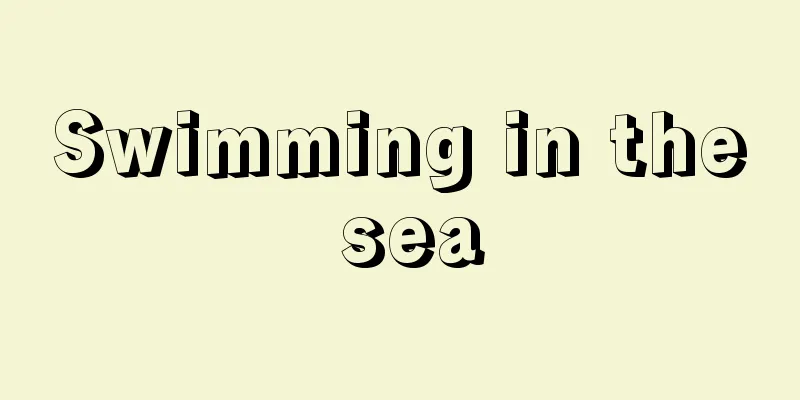Swimming in the sea

|
It is the act of bathing in the water on the coast to improve health, escape the summer heat, or for recreation. Today, sea bathing means swimming in the ocean, but originally it was a primitive form of natural therapy that has been practiced since ancient times in countries around the world for the purpose of restoring or improving health. In Japan, sea bathing has also been practiced for medicinal purposes since ancient times, under the names of shioami (sea bathing) and shiotouji (sea bathing). [Kosuke Sasajima] historySea bathing was practiced as a primitive medical method, but from the mid-18th century in England, the medical benefits of breathing sea air, drinking clean seawater, and immersing in seawater began to be touted. People drank seawater and stood in the water up to their waists all day. For sea bathing, large-wheeled carriages called bathing machines were made, and people drove the carriages into the sea and entered the water from the carriages. People discovered that sea bathing was beneficial not only for physical health but also for mental health, and sea bathing developed into a leisure activity. In Japan, the Azuma Kagami records that Minamoto no Sanetomo (1192-1219) cured his illness by bathing in the sea at Kamakura during the Kamakura period, and the poet Kamo no Chomei bathed in seawater at the beach in Ono, Owari Province, and wrote, "The taste of raw fish and the pure sake are good, I will bathe in Ono for many days." These prove that sea bathing was practiced as a form of seawater therapy. The term "sea bathing" was not used in Japan until the Meiji period. The term is a translation from a foreign language, and it is said to have been first used by Matsumoto Jun (Ryojun), a doctor of Western medicine. Pioneers who had studied Western medicine recognized the efficacy of sea bathing and sea therapy, which they learned from Western medicine, and made public, leading to its realization. In 1880 (Meiji 13), soldiers from the Osaka Garrison who had contracted beriberi were allowed to swim in the sea to recuperate at Akashi Beach in Suma, Hyogo Prefecture. In 1881, Aichi Prefectural Governor Kuninao Renpei consulted with Aichi Hospital Director Goto Shinpei to build a hut at Chidorihama Beach in Ono, a place where shio-toji (a traditional bathing spot) was practiced, and made it into a bathing beach. Matsumoto Jun, who became the Inspector General of the Army, recommended Terugasaki Beach in Oiso Town, Kanagawa Prefecture, as an ideal bathing beach, and opened the beach in 1885. Terugasaki Beach is considered the clear birthplace of Japanese bathing beaches. Nagayo Sensai also worked hard to make Kamakura a bathing beach. In this way, Japanese bathing beaches were opened by doctors as places for seawater therapy. However, from the 1890s, swimming clubs were established at schools along the coasts of Kanagawa and Chiba prefectures, and students began practicing swimming. In 1917, the Metropolitan Police Department banned swimming in the Sumida River due to the river's pollution, and the swimming training grounds that had been located in the Sumida River were moved to the sea. This led to a shift in the purpose of sea bathing from sea water therapy to simply swimming. After that, beaches were established on beaches all over the country, and more people began to use the beaches for swimming rather than for medical or recreational purposes, and sea bathing developed into the most popular summer recreation in Japan. In the 1970s, as seawater pollution became severe, the Environment Agency and the Ministry of Health and Welfare established water quality standards to determine whether beaches were suitable for swimming, and every year, they cooperate with the relevant local governments to publish the results of their surveys (the Ministry of Health and Welfare was also involved in the surveys when they first began, but later they came under the jurisdiction of the Environment Agency as a national agency, and in 2001 they came under the jurisdiction of the Ministry of the Environment, which was created as a result of a government reorganization). [Kosuke Sasajima] Effects and precautions of swimming in the seaSea bathing originally started as a form of seawater therapy, so if done with proper care, it can have a great effect on health. This is due to the mental benefits of a change of scenery, the fresh air at the beach, sunbathing, and the exercise of swimming. In particular, the repeated contraction of blood vessels due to the cold sensation and salt irritation when entering the water, and the reactive congestion that occurs when coming out of the water, are good for training the skin, and the action of the heat and ultraviolet rays of sunlight can also build up resistance. One thing to note is that the metabolic rate during sea bathing is seven or eight times higher than normal, even if you are swimming slowly, so even healthy people should be careful not to exercise too much. To do this, the time spent in the water should be short at first and gradually increased. Swimming in the sea can lead to excessive sunburn. Even short exposure to direct sunlight in seawater can cause burns and blisters on the skin. Sudden exposure to direct sunlight in order to get a tan should be avoided. Swimming should not be done when you are sleep-deprived, very tired, hungry or full, after drinking alcohol, or immediately after sweating. In addition, people whose tuberculin reaction has spontaneously turned positive within the last year, who have recently been treated for tuberculosis-related illnesses, who have ear diseases, fevers, heart disease, high blood pressure, anemia, diabetes, kidney disease, or epilepsy should not swim. Before entering the water, you should do some light warm-up exercises, and after swimming in the sea, you should wash your whole body with fresh water. [Kosuke Sasajima] Oiso-cho, Toya-gun, Kanagawa Prefecture (present-day Oiso-cho, Naka-gun). "Famous Places of Japan" (1900, Meiji 33), National Diet Library . Oiso Beach in the Meiji Period Source: Shogakukan Encyclopedia Nipponica About Encyclopedia Nipponica Information | Legend |
|
健康増進、避暑、レクリエーションとして海岸で水につかることである。現在では海で水泳をすることを海水浴というようになっているが、もとは健康回復や健康増進を目的として世界各国で昔から行われていた原始的な自然療法であった。日本でも古くから潮浴(しおあみ)、潮湯治(しおとうじ)などの名で医療のための海水浴が行われていた。 [笹島恒輔] 歴史原始的医療法として海水浴が行われていたのであるが、18世紀なかばごろよりイギリスで、海辺の空気を吸い、きれいな海水を飲み、海水に浸ることの医療的効果が唱えられだした。人々は海水を飲み、腰まで水に入って終日立っていたのである。この海水浴のために水浴マシンbathing machineとよばれる車輪の大きな馬車がつくられ、その馬車を海に乗り入れ、馬車から海に入ったのである。人々は、海水浴が体のみならず精神の健康にも役だつということを知り、レジャーとしての海水浴へと発展していった。 日本でも鎌倉時代に源実朝(さねとも)(1192―1219)が鎌倉の海に入って病を治したことが『吾妻鏡(あづまかがみ)』に書かれており、歌人の鴨長明(かものちょうめい)が尾張(おわり)国大野の浜で海水を浴び、「生魚のみあへもきよし酒もよし、大野のゆあみ日数かさねむ」と詠んでおり、海水療法としての海水浴が行われていたことがわかる。日本において海水浴という用語が使用されたのは明治になってからである。海水浴という用語は外国語からの訳で、初めて使用したのは蘭方医(らんぽうい)の松本順(良順)といわれている。西洋医学を学んだ先覚者たちが、西洋医学に教えられて海浜療法、海水浴の効能を認めて公表し、実現の運びにさせたのである。1880年(明治13)に兵庫県須磨(すま)明石(あかし)海岸で、脚気(かっけ)にかかった大阪鎮台の兵士に療養のため海水浴をさせている。1881年には愛知県令(現在の知事)国直廉平(くになおれんぺい)は愛知病院長後藤新平に諮って、同県にある潮湯治の故地大野の千鳥浜海岸に小屋掛けをして海水浴場とした。軍医総監となった松本順は神奈川県大磯(おおいそ)町照ヶ崎海岸を理想の海水浴場として推薦し、1885年に海水浴場を開いた。照ヶ崎海岸は日本の海水浴場の明確な発祥の地とされている。また、長与専斎(ながよせんさい)は鎌倉を海水浴場とするように尽力した。このように日本の海水浴場は、医者によって海水療法の場所として開かれていったのである。 ところが、1890年代から神奈川県、千葉県の海岸に各学校の水泳部が設けられて水泳の練習を始めた。また、1917年(大正6)に警視庁が川の汚れを理由に隅田(すみだ)川での水泳を禁止したことにより、それまで隅田川にあった水練場が海に移動したこともあって、海水浴は海水療法という目的からしだいに水泳をすることというように変わっていった。その後各地の海浜に海水浴場が設けられていき、医療や保養のためでなく、水泳の目的のために利用する人々が多くなり、海水浴は日本ではもっとも大衆的な夏のレクリエーションへと発展していった。1970年代に入ると海水の汚染が激しくなったため、環境庁と厚生省は海水浴場としての適否を判定するための水質基準を定め、毎年関係自治体と協力して調査の結果を発表している(調査開始当初は厚生省も関係していたが、その後、国の機関としては環境庁の所管となり、2001年以降は省庁再編によって誕生した環境省の所管となった)。 [笹島恒輔] 海水浴の効果と注意海水浴はもともと海水療法から始まったものであるので、適当な注意のもとに行えば健康上に大なる効果を得ることができる。それは、転地による精神的な効果、海浜の新鮮な空気や、日光浴、水泳による運動などにより健康上の効果は大である。とくに水に入ったときの冷感と塩類の刺激による血管の収縮、水から出たときにおこる反応的充血の繰り返しは皮膚の鍛錬によく、また、日光の熱線、紫外線の作用で抵抗力を養うことができる。注意すべき点としては、海水浴中の新陳代謝の量はゆっくりと泳いでも平常の7、8倍になるので、健康な人でも運動が過度にならぬよう注意すべきである。そのためには入水時間も初めは短くしてだんだんと長くしてゆくべきである。 海水浴においては過度の日焼けとなることがある。わずかな露出時間でも海水に浸っていることで直射日光を受けると皮膚に火傷を受けて火膨れができたりする。日焼けを誇るために急に直射日光に当たることなどは避けるべきである。睡眠不足のとき、疲れのひどいとき、空腹や満腹のとき、酒を飲んだあと、汗をかいた直後などには泳ぐべきではない。また、ツベルクリン反応が自然陽転1年以内、結核系の病気の治療後まもない場合、耳の疾患、発熱中、心臓病、高血圧症、貧血症、糖尿病、腎臓(じんぞう)病、てんかんの人などは泳がないほうがよい。水に入る前には軽く準備運動をしてから入り、海水浴を終わったあとでは真水で全身を洗っておかなくてはならない。 [笹島恒輔] 神奈川県淘綾郡大磯町(現在の中郡大磯町)。『日本之名勝』(1900年〈明治33〉)国立国会図書館所蔵"> 明治時代の大磯海水浴場 出典 小学館 日本大百科全書(ニッポニカ)日本大百科全書(ニッポニカ)について 情報 | 凡例 |
Recommend
Fukuroda Falls - Fukuroda Falls
Located in Fukuroda, Daigo-cho, Kuji-gun, at the n...
Arm bugs - Arm bugs
…A general term for arthropods belonging to the C...
Vardar
… [Kazunori Tanimoto] 【movie】 After World War II,...
Hydrogen exponent
…When the concentration of hydrogen ions in an aq...
Vitrinites
…The relationship between maceral groups, maceral...
initial
…Illuminations are also called miniatures. They i...
Man Singh, R.
...The reason why the town has been a constant so...
rouille
...When the seafood is cooked, remove it from the...
Karna (English spelling)
An ancient Roman goddess. According to the myth to...
Ishigaki [city] - Ishigaki
A city in Okinawa Prefecture that occupies the ent...
Flower vegetables
Vegetables such as cauliflower and broccoli, whose...
Mono (thing) - mono (English spelling) thing
In the narrow sense, it refers to objects in the o...
Stupid policy - Guminseisaku
It is one of the policies adopted to suppress the ...
Itasaka Bokusai (II)
...The latter include Nagatoya in Edo and Daiso i...
Sforza - Carlo Sforza
Italian diplomat and politician. He joined the Mi...









![Mononobe [village] - Mononobe](/upload/images/67cd05a402b21.webp)